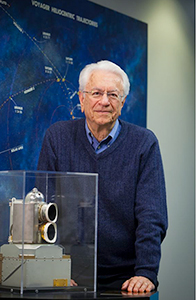Press Release
APL Space Scientist Receives National Air and Space Museum’s Lifetime Achievement Trophy
Thu, 03/26/2015 - 14:08
 Stamatios “Tom” Krimigis, who for 45 years has pioneered the exploration of our solar system and beyond while at the Johns Hopkins University Applied Physics Laboratory in Laurel, Maryland, has received the 2015 Smithsonian National Air and Space Museum Trophy for Lifetime Achievement, the museum’s highest honor.
Stamatios “Tom” Krimigis, who for 45 years has pioneered the exploration of our solar system and beyond while at the Johns Hopkins University Applied Physics Laboratory in Laurel, Maryland, has received the 2015 Smithsonian National Air and Space Museum Trophy for Lifetime Achievement, the museum’s highest honor.
Established in 1985, the award recognizes outstanding achievements in the fields of aerospace science and technology and their history. Few individuals have contributed more significantly to our knowledge of the solar system in a single career than Krimigis, according to Gen. (Ret.) J. R. “Jack” Dailey, director of the museum.
“Tom is one of our most storied and experienced scientists,” said Ralph Semmel, director of APL, “and we are tremendously proud of this recognition of a life propelled forward by scientific curiosity. His professional career coincided with the dawn of space exploration, and he and his colleagues took full advantage of that amazing opportunity. His visionary work developing new and innovative ways for NASA to explore the solar system provided the Laboratory with the opportunity to contribute engineering and science expertise to humanity’s quest to understand our universe.”
Krimigis, born in Chios, Greece, earned a bachelor’s degree in physics from the University of Minnesota and a master’s and doctorate in physics from the University of Iowa. He served on the faculty of the Physics and Astronomy Department at Iowa before joining APL in 1968. He headed the Space Physics and Instrumentation Group, became chief scientist in 1980, and became head of the Space Department in 1991, directing the activities of about 600 scientists, engineers and other technical and supporting staff members.
He has led or participated in space physics experiments on all eight major planets, the only scientist in the world to do so. He has served as principal investigator on five NASA missions — Cassini Orbiter, Voyager 1 and 2, Explorer 47/Interplanetary Monitoring Platform (IMP)-7, Explorer 50/IMP-8, and the Active Magnetospheric Particle Tracer Explorers — and as co-investigator on many others, and he is still active on missions to Mercury, Saturn, Pluto and the heliosphere.
He has designed, built, flown and analyzed data from 21 instruments on various NASA and European Space Agency missions. His Low-Energy Charged Particle instrument flies aboard both Voyager spacecraft; on Voyager 1, the LECP was instrumental to the discovery that a human-built vehicle had left the solar system for the first time. Krimigis was also instrumental in establishing NASA’s Discovery Program for low-cost planetary missions, which has sponsored 12 missions since its creation in 1992.
As a researcher, Krimigis’s publication record spans from “Interplanetary diffusion model for time behavior of intensity in a solar cosmic ray event,” published in the Journal of Geophysical Research in 1965, through “Search for the exit: Voyager 1 at heliosphere’s border with the galaxy,” published in Science in 2013. In all, he has published nearly 500 articles in scientific journals and books — including ground-breaking findings on solar observations, planetary magnetic fields, and the charged particles that flood the space between the planets — and is one of the most cited scientists in his field.
“Everything that happens in APL’s space programs today, in many ways, is Tom’s legacy,” said Mike Ryschkewitsch, head of APL’s Space Exploration Sector. “His work has contributed fundamentally to humanity’s knowledge of space and the planetary environments throughout the solar system, and has also provided the shifts in paradigms and leadership that have advanced — and continue to advance — astronautics and the exploration of space in a fundamental fashion.”